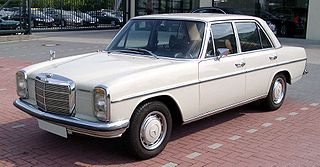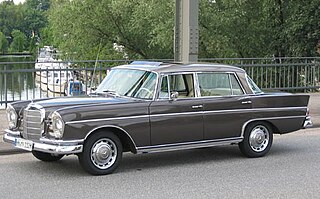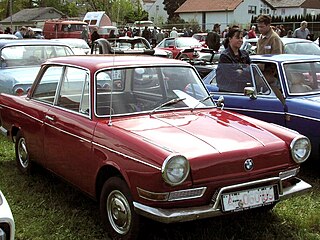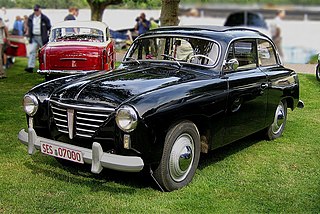
DKW was a German car- and motorcycle-marque. DKW was one of the four companies that formed Auto Union in 1932 and thus became an ancestor of the modern-day Audi company.

The former Borgward car manufacturing company, based in Bremen, Germany, was founded by Carl F. W. Borgward (1890–1963). It produced cars of four brands, which were sold to a diversified international customer base: Borgward, Hansa, Goliath and Lloyd. Borgward's Isabella was one of the most popular German premium models in the 1950s, while Lloyd's Alexander / Lloyd 600 model offered affordable mobility to many working-class motorists. The group ceased operations in 1961, following controversial insolvency proceedings.

The Mercedes-Benz W114 and W115 were the internal designation Mercedes-Benz used for a generation of front-engine, rear-drive, five-passenger sedans and coupés introduced in 1968, with three-box styling by Paul Bracq — succeeding the W110 models introduced in 1961; and manufactured until model year 1976, when the W123 was released.
Hansa-Automobil Gesellschaft m.b.H was a German car brand established in 1905, which in 1914 was merged with Norddeutsche Automobil und Motoren AG (NAMAG) into Hansa-Lloyd-Werke A.G.. From 1929 to 1931 it was taken over by the Borgward group. Hansa was based in the Bremen suburb of Hastedt.

The Mercedes-Benz "Ponton" series are a range of sedans / saloon car models from Daimler-Benz, introduced starting in 1953, and subsequently nicknamed 'Ponton', referring to its ponton styling, a prominent styling trend that unified the previously articulated hood, body, fenders and runnings boards into a singular, often slab-sided envelope. At the time, Mercedes itself did not refer to any of its cars using the nickname.

The Mercedes-Benz W112 is a luxury automobile produced by Mercedes-Benz from 1961 to 1967. Marketed as the 300SE, it was available as a coupé, convertible, sedan, and stretched sedan (Lang), all generally similar in appearance to the corresponding Mercedes-Benz W111.

The BMW 700 is a small rear-engined car which was produced by BMW in various models from August 1959 to November 1965. It was the first BMW automobile with a monocoque structure. The 700 was a sales success at a time when BMW was close to financial ruin. The 700 was also successful in its class in motorsport, both in its stock form and as the basis of a racing special called the 700RS.

Eucort was a Spanish automobile manufacturer based at Barcelona from 1945 till 1953.

The Holden FJ series is a range of motor vehicles which was produced in Australia by Holden from 1953 until 1956. The FJ was the second model of an "all Australian car" manufactured by Holden and was based upon the established 48-215 series, commonly referred to as the "FX".

The Borgward Isabella is an automobile which was manufactured by the Bremen based auto-manufacturer Carl F. W. Borgward GmbH from 1954 to 1962.

The BMW 501 was a luxury car manufactured by BMW from 1952 to 1958. Introduced at the first Frankfurt Motor Show in 1951, the 501 was the first BMW model to be manufactured and sold after the Second World War, and as the first BMW car built in Bavaria. The 501 and its derivatives, including the V8 powered BMW 502, were nicknamed “Baroque Angels” by the German public. The BMW 502 was the first postwar German car to be manufactured with a V8 engine.

The Borgward Hansa 2400 was an executive six-cylinder saloon (E-segment) presented in 1951, and manufactured by the Bremen based auto-manufacturer Carl F. W. Borgward GmbH from 1952 until 1959. The car was launched as a four-door fastback saloon; a longer-wheelbase notchback version appeared a year later. The Hansa 2400 suffered from teething troubles including inadequate brakes and problems with the automatic transmission Borgward developed for it. In a small closely contested market, the large Borgwards lost out to less flamboyant models from the German south.

The Goliath GP700 is a small automobile which was manufactured by the Bremen, Germany–based Borgward subsidiary Goliath-Werke Borgward & Co from 1950 to 1957. In 1955, the GP700 was joined by the larger-engined Goliath GP900 E. From 1951 to 1953, a coupé version, the Goliath GP700 Sport was offered. The Goliath was a revolutionary design, which in several important respects pointed the way for automobile development in the second half of the 20th century.

The DKW F8 is a compact front-wheel drive two-stroke engined saloon, introduced in 1939. The F8 was slightly shorter than its predecessor despite having a marginally increased wheelbase. The base model, known as the Reichsklasse, was manufactured only till 1940 but the Meisterklasse sedan continued in production until 1942. In addition to the saloons, cabriolet versions were offered.

The DKW Junior is a small front wheel drive saloon manufactured by Auto Union AG. The car received a positive reaction when first exhibited, initially badged as the DKW 600, at the Frankfurt Motor Show in March 1957. The ‘Junior’ name was given to the DKW 750 in 1959 when the car went into volume production, but failed to survive an upgrade in January 1963, after which the car was known as the DKW F12. In addition to the saloon, a pretty ‘F12 Roadster’ was produced in limited numbers.

The Goliath Pionier is a small three-wheeled two-seater vehicle first presented by Carl F. W. Borgward at the 1931 Berlin motor show. It remained in production until 1934, by when approximately 4,000 had been produced.

The Talbot Lago-Record Type T26 was a large, six-cylinder executive car launched by the French Talbot company in 1946. In the context of the company's protracted financial collapse, the last T26s were probably those produced during 1953.

The Lloyd 600 is a small car produced by the Borgward Groups's Lloyd Motoren Werke GmbH in Bremen between 1955 and 1961.

The Lloyd Arabella was a passenger car produced by the Borgward Group in West Germany between 1959 and 1961. After the company's controversial bankruptcy the Arabella continued to be produced, albeit in greatly reduced quantities and branded as the Borgward Arabella until 1963. By the standards of the time and place it would have been defined as a small family car.

The Lloyd 300 was a small car produced by the Borgward Group's Lloyd Motoren Werke GmbH in Bremen between 1950 and 1952.



















